INTRODUCING HAWORTHIAS
By Valery Zlotin, Moscow, Russia
Translated from Russian by Irina Ten
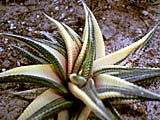
Haworthia limifolia f.variegata
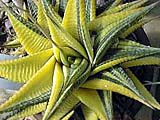
Haworthia limifolia variegated marloth
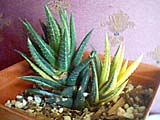
Haworthia coarctata
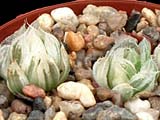
Haworthia coarctata e of atherstone
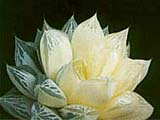
Haworthia cymbiformis f.variegata
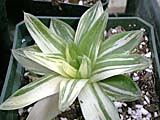
Haworthia cymbiformis f.variegata
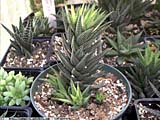
Haworthia f.variegata
| | | | | | |
Members of the genus Haworthia (the Liliaceae family) are mostly stemless succulents with thick leaves forming rosette. Leaves are often serrated or ciliate on edges. Many species have leaves with translucent areas ("windows") or covered with tubercles which usually have white color. Some species have short stem, tightly embraced with spirally arranged leaves. Flowers of haworthias are greenish or pinkish white, small and plain. The habitat of Haworthia is South Africa. Some species were described as the Aloe species in 1695. In 1809 Duval separated them into the distinct genus Haworthia named after the famous English succulent researcher Adrian Hardy Haworth.
Haworthias can be often seen on windowsills of our house plant lovers but assortment of species is quite poor and many beautiful species are unknown to our collectors. In our climate haworthias are very suitable plants for indoor cultivation. First of all, they are rather diminutive plants and one windowsill can hold quite a collection. Secondly, they are not light-demanding and develop well even in low light conditions. And thirdly, haworthias can be easily propagated asexually since they offset readily.
Taxonomists divide genus Haworthia into three subgenera but this division reflects purely botanical relations between species. For myself, I amateurishly divide haworthias into five groups by appearance.
The Aloe-like group includes such well-known species as H. chloracantha, H. cooperi, H. limifolia, H. fasciata, H. tesselata and rarer H. koelmaniorum, H. pumila, H. marumiana and others.
H. pumila
H. koelmaniorum
The Pillar group includes very popular in our collections H. reinwardtii, quite well-known H.armstrongii, H. coarctata, H. viscosa, also H. glauca, and very rare H. nigra. These species have short stems, tightly embraced with spirally arranged leaves.
H. glauca v. herrei
The Flat group consists of the exceptionally beautiful plants that have flat-topped ("cut") leaves, usually with translucent windows. In habitat these plants are often submerged entirely in the ground, leaving only the flat tops of the leaves on the surface. The most common in collections is H. truncata, a miniature masterpiece of nature. This species has a form of a fan or an open book, not a rosette. H. retusa also occurs in the collections. But many wonderful species are unknown among collectors, such as H. bayeri, H. comptoniana, H. emelyae, H. magnifica, H. maughanii, H. mirabilis, H. mutica, H. pygmea, H. springbokvlakensis and others.
H. retusa v. acuminata
H. comptoniana
H. maughanii
The Laced haworthias are with cilia on the edges of leaves that gives plants their "laced" appearance. This group includes H. arachnoidea with many varieties, H. bolusii, H. decipiens, H. lockwoodii, H. xiphiophylla and some others. Unfortunately, these wonderful species are not popular.
H. arachnoidea
And the last group, the Grass-like haworthias, in which I include H. blackburniae, H. longiana and H. wittebergensis with thin long leaves. For example, leaves of H. blackburniae have diameter 3-5 mm and grow up to 40 cm.
Cultivation of haworthias is quite simple. As I mentioned above, they can be grown in low light conditions, but the "real" colors - bronze, black, chocolate - can be obtained only under the full sun exposure. For haworthias I use very loose soil mix composed of equal parts of leaf compost, sand and small clay pellets. Many foreign collectors recommend watering haworthias only during three spring and three fall months and keeping plant dry in winter and summer. But in the moderate climate zone of Russia summer is not that hot as in SAR or in USA and our plants winter not in greenhouses, but in apartments with very dry air. That is why summer hibernation is optional for them and dry wintering causes drying out of outer leaves and that blemishes appearance of the plants. So I water my collection of haworthias twice a week during May-September, once a month during October-November and March-April, and once in month and a half during December-February. About every other time I add liquid fertilizer to water. If one decides to keep plants dry in winter I would recommend repotting all the plants before the first watering, because after the full drying out of soil most parts of roots die off, and after watering, the remains start to rot.
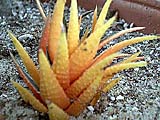
Haworthia fasciata f.variegata
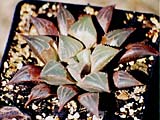
Haworthia mirablis ssp mundula
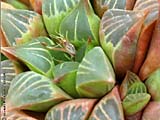
Haworthia retusa
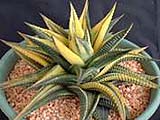
Haworthia limifolia f.variegata
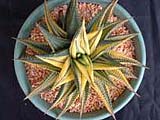
Haworthia limifolia f.variegata
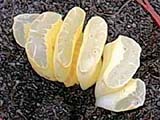
Haworthia truncata variegate skulkin
| | | | | |





